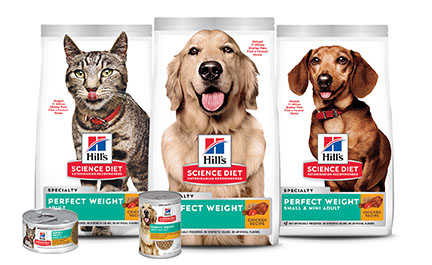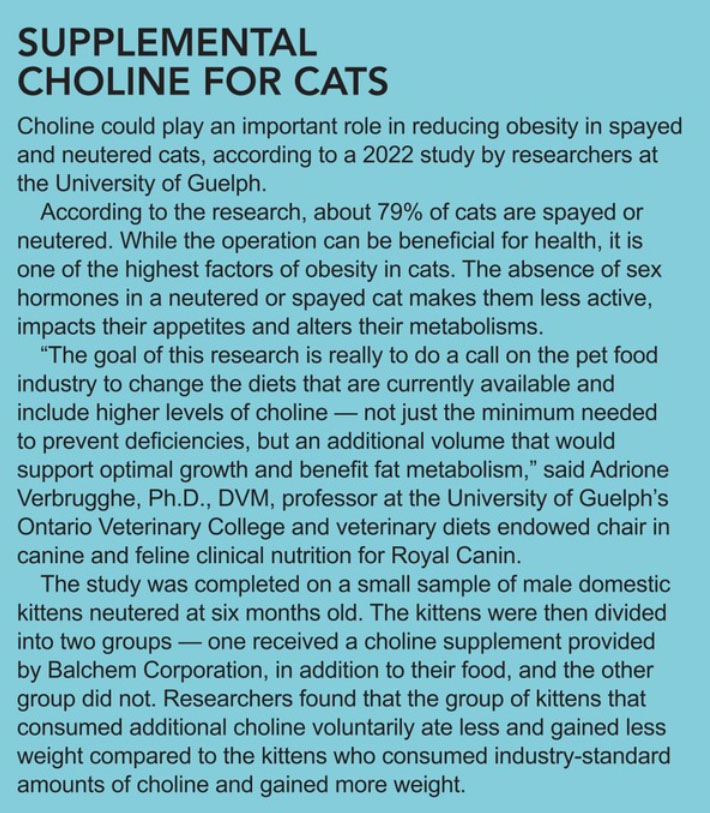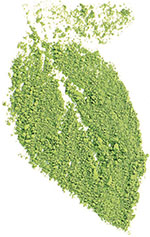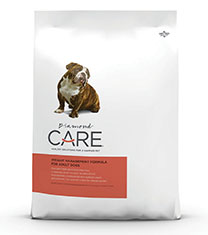The percentage of dogs and cats considered overweight or obese in the United States has been rising steadily since 2010, according to the Association for Pet Obesity Prevention (APOP). In 2018, APOP shared 60% of cats and 56% of dogs across the country were deemed overweight or obese by a veterinary professional. This amounts to roughly 50 million dogs and 56 million cats.
Banfield Pet Hospital went so far as to classify pet obesity as an epidemic in its 2020 Veterinary Emerging Topics (VET) Report and, considering the serious health risks associated with sustained obesity, the severity of that statement is no exaggeration.
Weight-related health risks
Pet obesity can have serious health repercussions, including a shortened lifespan and contributing to other conditions, many of which stem from low-grade chronic inflammation caused by excess body fat, according to Jason Gagné, DVM, DACVIM (nutrition), director of veterinary technical communications, Nestlé Purina PetCare, St. Louis.
“Obese dogs have an increased incidence of traumatic or degenerative orthopedic disorders, neoplasia, cardiovascular and respiratory disease, hypertension, diabetes mellitus and skin disorders,” said Mark Brinkmann, vice president of operations, Diamond Pet Foods, Meta, Mo. “Obese cats are nearly four times more likely to develop diabetes mellitus than lean cats and three times more likely to develop lameness.”

Hill’s Pet Nutrition’s Science Diet Perfect Weight line offers dry and wet diets formulated with high levels of fiber and protein, L-carnitine and coconut oil to support health metabolism and body weight in dogs and cats.
|Renee Streeter, DVM, DACVIM (Nutrition), nutrition practice principal, BSM Partners, Bentonville, Ark., backed this up by noting an estimated 31% of diabetes mellitus and 34% of lameness cases in cats are attributed to body weight issues. Juan Javierre, nutrition scientist, Layn Natural Ingredients, Irvine, Calif., shared obesity can indicate a more complex disease — obesity-related metabolic dysfunction (ORMD) — which leads to dyslipidemia, high blood pressure and low adiponectin levels.
“Health risks include increased risk for heart and respiratory disease, exercise intolerance, joint and mobility problems, increased cancer risk, and glucose intolerance (diabetes),” said Karen Shenoy, DVM, chief veterinary officer, Hill’s Pet Nutrition US, Topeka, Kan. “Studies have also demonstrated reduced quality of life and shorter lifespan in obese pets.”
According to Dana Brooks, president and chief executive officer, Pet Food Institute, Washington, DC, studies have shown dogs that maintain an ideal weight may live up to two and a half years longer than overweight dogs.
“The good news is that obesity is a preventable disease,” said Theresa Lantz, MSC, companion animal nutritionist, Petcurean, Chilliwack, British Columbia.
Counting calories
Pet treats are a key culprit for pet obesity. According to Streeter, treats should make up only 10% of a pet’s caloric intake per day, but this guideline is often exceeded through dental treats, biscuits, jerky treats, chews, and even functional treats or supplements.
“Even treats that can offer huge benefits like dental treats or functional treats that have beneficial supplements can cause more harm than good if they are not fed properly,” she said. “In order for dental treats to be safe and effective, the pet must chew, but not swallow, large pieces of the treat. Due to these chews needing to be large enough to accommodate this purpose, this larger size naturally comes with a larger calorie count. Because of the increased size and calories, if a dental treat is given each day, there is likely no room for other treats in the diet.

“Treat manufacturers can do a service to pets by always including appropriate feeding guidelines for their products and having an accurate assessment of the calories per treat in order to help prevent not only obesity, but an unbalanced diet,” she added.
Treating less frequently is one solution. However, when it comes to weight management pet food formulations, simply feeding less won’t do the trick.
“A therapeutic diet is the appropriate option since we want to increase, decrease and add certain nutrients to help pets achieve an ideal body weight and condition,” Gagné said. “It is not recommended to simply feed less, since you will be lowering all nutrients in addition to the fat content.”
Therapeutic approaches
In a weight management pet food formula, higher protein levels can support fat loss while preserving lean body mass, and lower fat levels can cut calories and reduce the energy density of a diet, Gagné said. Fiber can also play a crucial role in satiety, or how full a pet feels between mealtimes.
“Weight loss formulations focus on high protein and high fiber to help dogs and cats feel more full,” Streeter said. “In addition, this high fiber inclusion can help to reduce calorie density of the diet, which means dogs and cats can eat more food while still having a reduced calorie intake. Having a diet which is low in fat also helps with this, as low-fat foods are known to help improve weight loss overall.”
Lantz noted psyllium husk, which is rich in soluble fiber, can help keep pets feeling full. Ingredients that are rich in insoluble fiber, such as peas and pea fiber, can be included in a diet to deliver extra bulk and allow increased total intake without adding on the calories, she said.
“For dogs, low-fat and high-fiber diets can lead not only to weight loss but also to a decrease in body fat percentage and an increase in lean body mass,” Brinkmann said. “For cats, diets featuring high-quality protein and Omega 3 fatty acids are important for safe weight loss. These formulas also contain the supplement L-Carnitine, a nutrient that helps the body convert fat to energy and supports a lean body condition, and insoluble fiber, which helps pets feel full.”

Polyphenol-rich botanical extracts, such as green tea extract, can address the root causes of oxidative stress and inflammation that occur with obesity-related metabolic dysfunction.
|According to Streeter, supplemental L-carnitine can support fat metabolism and muscle mass maintenance. This amino acid can be leveraged to help pets burn fat more efficiently, Gagné added.
Petcurean’s GO! SOLUTIONS WEIGHT MANAGEMENT + JOINT CARE formulas for dogs and cats are formulated with L-carnitine to support fat burning and heart health. Other ingredients include a fiber-rich psyllium husk and flaxseed to help with satiety, as well as supplemental glucosamine and chondroitin in the dog recipe to support mobility, Lantz shared. The cat food recipe specifically includes increased levels of dietary choline, which has been shown to support fat metabolism in cats and has been the focus of recent research by Alex Rankovic, Ph.D., at the University of Guelph on nutritional weight management strategies.
Because obesity can cause stress to a pet’s joints, ingredients that address mobility — such as glucosamine and chondroitin — can also benefit a weight management formulation. The inclusion of fish oils, which are touted as good sources of Omega fatty acids EPA and DHA, can help relieve joint inflammation and increase insulin sensitivity.
Diamond Pet Foods’ CARE Weight Management diets for dogs and cats combine supplemental L-carnitine, Omega 3 fatty acids, antioxidants and probiotics in low-fat, high-fiber formulas to support weight management and aid symptoms of pet obesity, Brinkmann shared.
“Fish oils contain EPA and DHA, and higher concentrations of EPA in the blood have been associated with an increased concentration of adiponectin, an insulin sensitizing hormone, in dogs and cats,” Streeter explained. “Future prospective studies could investigate the potential to utilize fish oils which are high in EPA in the diet to understand if it has any potential effect on insulin sensitization and body condition, as well as body composition in dogs.”
"Weight loss formulations focus on high protein and high fiber to help dogs and cats feel more full,” said Renee Streeter, DVM, DACVIM, BSM Partners.
Isoflavones also offer antioxidant and anti-inflammatory properties. When included in a weight management diet, these compounds can increase daily energy expenditure, reduce oxidative stress and weight gain, and decrease fat accumulation, according to Gagné.
“Purina recently completed a six-month clinical study that compared a metabolic test diet with those of a control diet, and we found that the dogs on the metabolic diet, which features a 3:1 protein-to-starch ratio, natural fiber, L-carnitine and isoflavones, lost significantly more body fat that dogs on the control diet with minimal loss of lean body mass,” he said. “Meanwhile, dogs in the control group lost significantly more lean body mass compared to dogs fed the test diet.”
Ingredients that are rich in polyphenols can address the root cause of oxidative stress and inflammation, Javierre noted, which are common symptoms of ORMD and can exacerbate weight and joint health issues. Layn Natural Ingredients’ TruGro Weight Management ingredient is a green tea extract rich in epigallocatechin gallate, as well as other catechins and polyphenols. The ingredient is designed to support metabolism, reduce metabolic oxidation, and promote glucose absorption when incorporated in a weight management diet, he added.
“A study published in the British Journal of Nutrition demonstrated that green tea extracts provided to obese dogs may decrease insulin resistance, improve triglyceride profile, and aid in the metabolization of lipids and glucose, thereby improving the metabolic status of dogs,” Javierre said.
The emerging science of nutrigenomics points to activating a pet’s metabolism as a method of weight management. According to Shenoy, pet food formulas like Hill’s Pet Nutrition’s Prescription Diet Metabolic are formulated to do just this and have been clinically proven to promote weight loss in obese pets. Hill’s Pet Nutrition also offers wellness options for weight management under its Science Diet moniker. Pet owners should consult with their veterinarian to select the most appropriate food.
“Obesity is a consequence of increased energy intake, reduced energy expenditure, or both,” Javierre said. “Pet food and treat manufacturers can help by formulating energy-reduced diets and treats to avoid excess calorie intake and integrating functional ingredients to help with weight management and joint health. They could also help with advocacy to educate customers about the importance of food discipline to avoid this condition.”
Pet owner education
The loving eyes of most pet owners tend to overlook their pets’ plumpness — only 39% of dog owners and 45% of cat owners consider their pet to be overweight, despite statistics claiming pet obesity affects more than half of all pets, according to APOP’s 2021 Pet Obesity Pet Food Survey. Moreover, Javierre cited a recent study that points to a 78% correlation between pet obesity and pet owner obesity.
Providing science-based nutritional options is part of the solution, but this alone won’t be enough to curb pet obesity. There is a significant opportunity to engage and educate pet owners on how to help their pets lose and manage weight.

Diamond Pet Foods’ CARE Weight Management formulas for dogs and cats are designed to not only help pets lose weight, but also maintain more ideal body weights.
| Source: Diamond Pet FoodsTo facilitate this effort, Hill’s Pet Nutrition continues to invest in its annual End Pet Obesity campaign, through which the company provides educational and practical weight management resources for pet owners. These include common physical and behavioral signs of obesity, opportunities to engage pets in more physical activity, and a list of conversation starters to help pet owners discuss weight management strategies with veterinary professionals.
Pet Food Institute also works to equip consumers with pet weight management tools, such as feeding a complete-and-balanced diet and avoiding the urge to indulge pets in table scraps or too many treats. The association recommends that pet owners schedule regular veterinary visits, follow the recommended feeding guidelines provided on pet food and treat labels, and spend quality time with pets through activity, which can benefit weight management, mobility and cognitive stimulation.
“It’s also important to remember that there is no one-size-fits-all approach to pet nutrition,” Lantz said. “By offering pet food options that consider specific dietary needs — like obesity — we are supporting pet parents in making the best pet food choice for their dog or cat.”
Read more about product development, ingredients and formulation.





